Understanding Bird Collar Plucking: Causes and Solutions
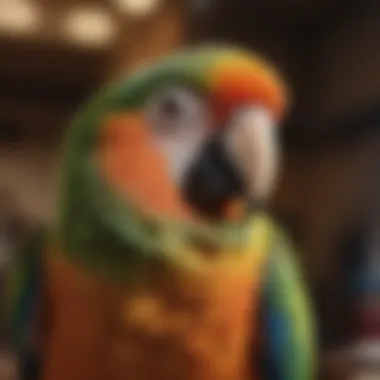
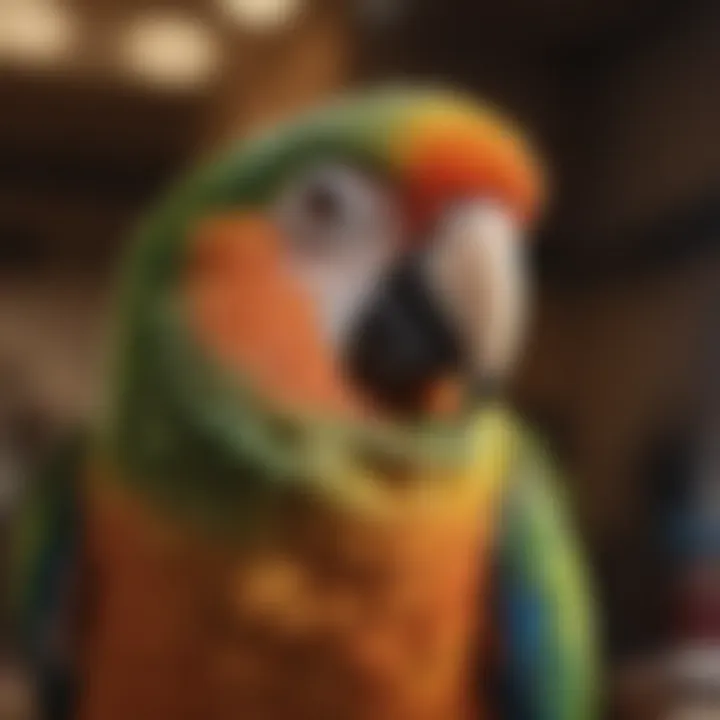
Intro
Bird collar plucking is a behavior that can raise concern among pet bird owners. This issue does not just affect the aesthetics of a bird's appearance; it signals deeper psychological or physical problems. Understanding why a bird engages in collar plucking is crucial for appropriate intervention. This article sets out to explore the causes, implications, and solutions to this behavior, providing a comprehensive guide for both new and seasoned bird enthusiasts.
Care Tips
Caring for a bird involves more than just providing food and water. Daily care routines and proper cage setups contribute to a bird’s overall health and well-being.
Daily Care Routines
Regularly checking on your bird, engaging with them, and providing enrichment are vital. Establish a routine that includes feeding, cleaning, and interaction. Consistency helps foster a sense of security for your bird, which may reduce stress-related behaviors, including collar plucking.
Cage Setup and Maintenance
The cage should be spacious and stimulating. Birds need room to move and play. Include perches of various sizes and textures to keep their feet healthy. Avoid overcrowding the cage with toys, but ensure that there are enough to engage their curiosity. A clean environment also reduces chances of illness, which can provoke anxiety and lead to collar plucking.
Hygiene and Cleaning Practices
Cleaning involves more than just removing waste; it ensures a healthy habitat. Regularly wash food and water bowls to prevent bacteria. Spot clean daily and perform a deep clean weekly. Disinfect the cage and replace bedding materials to keep the area fresh.
Seasonal Care Adjustments
Birds can be sensitive to changes in temperature and humidity. In colder months, ensure they have a warm area in their cage. Conversely, in summer, provide adequate ventilation and avoid direct sunlight. Adjusting the care routine for the seasons can prevent stressors that may contribute to collar plucking.
Behavioral Insights
Understanding bird behavior is key to managing any issues they face, including collar plucking. By observing their body language, one can better comprehend their needs and emotions.
Understanding Bird Body Language
Birds communicate through various gestures. For instance, a puffed-up bird may feel threatened, while a bird that regularly flaps its wings might need more exercise. Recognizing these signs helps owners respond appropriately.
Common Behavioral Issues and Solutions
In addition to collar plucking, other behavioral issues can arise. Excessive screaming, biting, or withdrawal may indicate distress. Providing a variety of interactions can help alleviate these behaviors.
Positive Reinforcement Techniques
Instead of scolding for unwanted behaviors, focus on rewarding positive actions. Use treats or praise effectively to encourage good habits. This method fosters trust and a healthy attachment between the bird and owner.
Social Interaction Needs
Birds are social creatures. They need interaction, whether it’s with humans or other birds. Schedule playtime and social activities to stimulate their minds and improve mental health.
Nutrition Guides
Feeding your bird a balanced diet is paramount. The right nutrition supports physical and mental well-being and can help mitigate behavioral issues.
Essential Diet Components
A proper diet should include seeds, pellets, fruits, vegetables, and nuts. Each bird species has specific dietary needs. Research what is essential for your bird’s species.
Safe and Toxic Foods
Certain foods can be harmful or even fatal to birds. Avoid avocados, chocolate, and caffeine. It's crucial to know what is safe for your pet to ensure their health and safety.
Supplements and Treats
Providing vitamins and supplements can also be beneficial, particularly in stress-reducing situations. Offer small, healthy treats occasionally to keep your bird interested in their diet.
Feeding Strategies for Different Species
Different bird species may have differing requirements in terms of quantity and type of food. Tailor your feeding strategy to meet the specific needs of your bird.
Wellness and Health
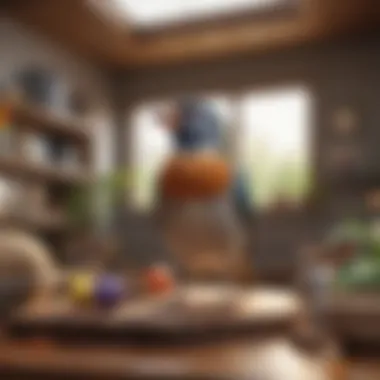
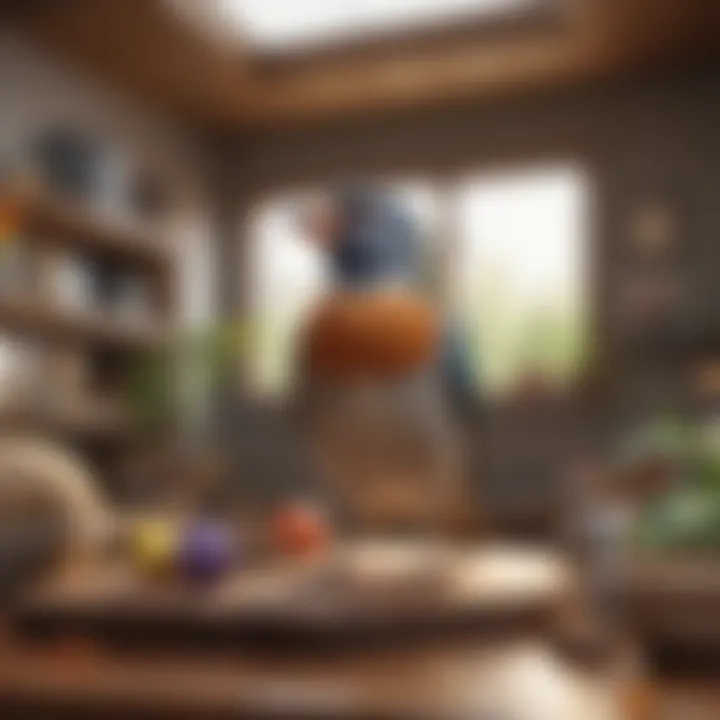
Routine health checks and preventative care are essential in managing a bird's well-being. Regular monitoring can catch potential problems early.
Routine Health Checkups
Plan regular visits to an avian vet. These checkups help identify any health issues and ensure your bird is in good condition. Early detection can prevent serious health problems later.
Identifying Symptoms of Illness
Watch for symptoms like lethargy, changes in appetite, and alterations in behavior. These signs may indicate a health issue that requires attention.
Preventative Care and Vaccinations
Keep vaccinations up to date. Preventative care is often the best approach to ensure a long and healthy life for your bird.
Mental and Emotional Well-being
The psychological aspect of bird care is significant. Enrichment activities and social interactions contribute to emotional stability, which may help reduce collar plucking incidents.
Enriching Activities
Providing engaging activities for your bird is critical for their mental health.
Toys and Playtime Ideas
Offer varied toys to stimulate your bird's curiosity. Rotate them regularly to maintain interest. Interactive toys can also promote physical activity.
Training and Tricks
Training your bird to perform tricks can strengthen your bond and enrich their environment. Use gentle methods and rewards to encourage learning.
Outdoor Activities and Interaction
Supervised outdoor time can provide mental stimulation. Fresh air and sunlight can have positive effects on overall well-being.
DIY Projects for Mental Stimulation
Creating homemade toys from safe materials can engage your bird's mind and reduce boredom. Just ensure any materials used are non-toxic.
Addressing collar plucking in birds is not just about stopping a behavior; it is about creating a supportive environment that promotes health and happiness.
By understanding the various aspects of bird care, you can effectively manage collar plucking and enhance your pet’s quality of life.
Prelude to Bird Collar Plucking
Collar plucking in birds is a behavior that raises significant concerns for many avian enthusiasts and pet owners. Understanding this issue is not just about addressing a superficial habit; it is about ensuring the health and happiness of our feathered companions. The topic warrants close attention because collar plucking can indicate deeper psychological or physical problems. Addressing this behavior allows owners to enhance their birds' living conditions and promote their overall well-being.
Defining Collar Plucking
Collar plucking refers to the act where a bird pulls out its own feathers, specifically around the collar area of its neck. This action may start slowly but can escalate quickly if not managed. It often results in patches of missing feathers and can lead to various complications, both physically and psychologically. While feather plucking can occur anywhere on the body, collar plucking is particularly alarming due to its visibility and potential adverse effects on the skin and underlying tissues.
Prevalence Among Bird Species
Various bird species exhibit collar plucking, but some are more prone than others. Parrots, for example, show a notable incidence of this behavior, particularly in species like the African Grey parrot and the Amazon parrot. Cockatoos also frequently engage in this plucking. However, it is not limited to these types. Even smaller birds, such as budgerigars and canaries, can develop this habit under certain circumstances.
- Parrots: Frequently pluck due to social needs and environmental factors.
- Cockatoos: High intelligence and emotional needs make them vulnerable.
- Canaries: May show symptoms due to stress or health issues.
As observed, collar plucking is not confined to a specific group; it affects various species. Understanding why some birds are more liable can help owners be proactive in preventing it.
The Anatomy of Bird Plucking Behavior
Understanding the anatomy of bird plucking behavior is essential for both pet owners and bird enthusiasts. This behavior often indicates deeper issues that can affect the well-being of birds. By analyzing this pattern closely, we can uncover not just the behavior itself but also the underlying causes and solutions that may alleviate the issue.
Understanding the Collars
The "collar" refers to the area of feathers around the neck and head of a bird. In many species, such as parrots and cockatiels, these feathers serve both aesthetic and functional purposes. When birds begin to pluck their collar feathers, it may stem from various sources, including stress or discomfort.
Collar feathers are uniquely important. They protect sensitive skin and serve roles in social interaction among birds. Observing the collar areas can offer immediate insight into their conditions. If a bird is losing collar feathers, it can be an early signal of health problems or anxiety.
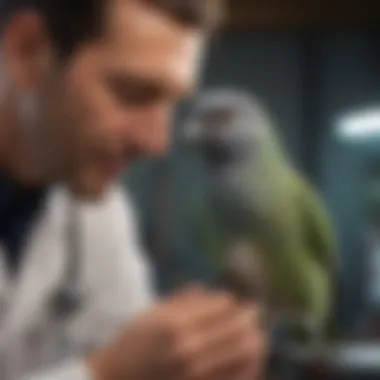
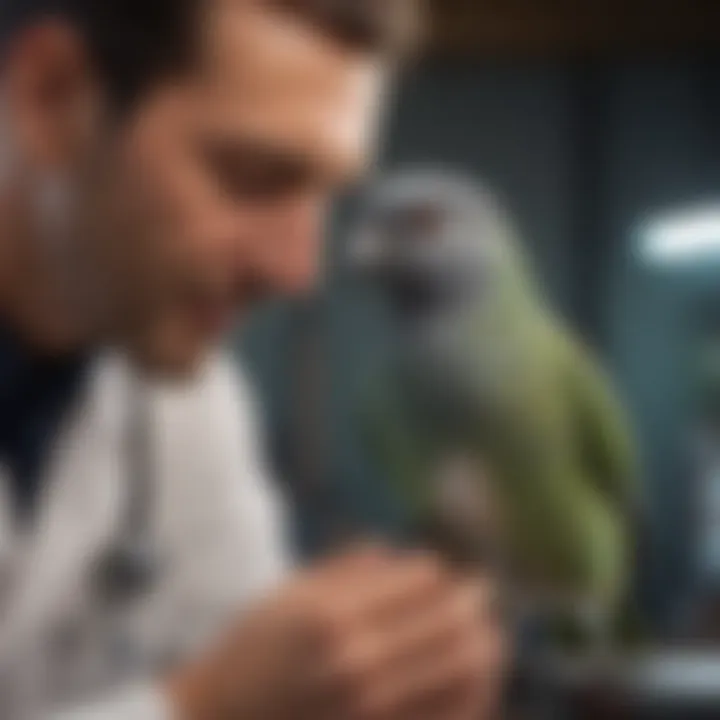
Additionally, skin health in this area is crucial. Irritations or injuries can prompt scratching and further plucking, leading to a cycle of issues. Owners should always visually inspect and maintain feather condition to minimize problems as they arise.
Some key aspects concerning the collar area include:
- Physical protection: The collar feathers provide a barrier against environmental stressors.
- Social signaling: Many birds use their collar feathers in mating displays or territorial behaviors.
- Comfort: A healthy collar area can indicate general wellness in a bird.
Behavioral Indicators
Recognizing behavioral indicators of collar plucking can provide insights into a bird's emotional state. Each bird displays different signs when experiencing anxiety or discomfort. Common behaviors include excessive grooming, head shaking, or even aggression toward others.
Some specific indicators to look for are:
- Increased vocalization: Birds may become more vocal, indicating restlessness or stress.
- Changes in activity levels: A previously active bird that becomes withdrawn may suffer from mental health challenges.
- Destructive behaviors: Chewing on cages or toys can also signal environmental distress.
Monitoring a bird's behavior is vital. Not only does it help in diagnosing problems early, but it also enables effective management of their environment and emotional health. Understanding the indicators may assist pet owners in creating a nurturing space that discourages harmful behaviors like collar plucking.
"Birds express their inner emotional states through their behaviors. Understanding these cues can transform their living conditions and enhance their welfare."
By focusing on these anatomical and behavioral elements, pet owners and aficionados can better comprehend bird collar plucking. It serves as a foundation for developing effective strategies to ensure the health and happiness of their avian companions.
Causes of Bird Collar Plucking
Understanding the causes of bird collar plucking is critical for effective management and intervention. This behavior often signals underlying issues that can affect a bird’s physical and emotional health. By identifying these causes, owners can tailor their approach to prevent further harm and promote a better quality of life for their pets. Addressing the root causes ensures that the solutions applied are appropriate, increasing the chances of successful outcomes.
Psychological Factors
Anxiety and Stress
Anxiety and stress are significant contributors to collar plucking. Birds may experience stress due to various factors, such as changes in environment or routine. A key characteristic of anxiety in birds is increased vocalization or frantic movements. This aspect is vital because comprehending these signals can help owners address the source of stress. The unique feature here is that birds are sensitive to changes, even ones that seem insignificant to humans. This sensitivity can lead to repeated collar plucking, causing self-inflicted injuries.
Fear and Trauma
Fear and trauma can deeply impact a bird's behavior, leading to collar plucking as a coping mechanism. Recognizing fear-induced plucking is crucial, as it helps highlight the severity of past experiences the bird may have suffered. A notable characteristic is that birds may exhibit avoidance behavior or become overly aggressive when faced with triggers. This emotional baggage connects directly to their tendency to pluck at their feathers, including the collar area. While understanding fear can empower owners to create safe environments, overcoming trauma may require professional intervention.
Physical Causes
Skin Irritation
Skin irritation is another significant factor influencing collar plucking. Irritated skin can lead to excessive itching, prompting birds to pluck their feathers as a response. The characteristic feature of this issue is redness or scabs in the affected areas. Recognizing this condition is beneficial as it prompts immediate action from owners to assess potential causes, such as allergies or unsuitable materials in their environment. One disadvantage is that skin irritation can escalate quickly if left untreated, leading to further complications.
Parasites
Parasites can also be a direct cause of collar plucking. Infestations by mites, lice, or other external parasites create discomfort that leads birds to engage in plucking behaviors. The key characteristic of this challenge is that it often presents with visible symptoms, such as feather loss or skin irritation. Addressing parasite issues becomes vital, as they can cause severe consequences on the bird’s health if not remedied. Recognizing these signs early allows for prompt veterinary action.
Environmental Triggers
Changes in Routine
Changes in routine can be an unexpected trigger for collar plucking. Birds thrive on stability; even minor modifications can induce anxiety. A major characteristic of this trigger is its subtlety; shifts in the household's schedule, or small alterations in daily habits could easily go unnoticed. Christine's such changes require vigilance from bird owners, as they might overlook the impact of their routines. However, keeping a consistent environment greatly benefits avian well-being.
Noisy Environments
Noisy environments contribute to bird stress, potentially leading to collar plucking. The bustling sound of daily activities, loud machinery, or frequent visitors can overwhelm birds, causing them to react in various ways. A key characteristic of this trigger is a flight response; birds may seek refuge or engage in self-destructive behaviors. Identifying excessive noise and its potential effects on your bird is crucial. Owners must strive to create a calm space that allows their avian companions to feel secure.
Implications of Collar Plucking
Understanding the implications of collar plucking is essential for bird owners. This behavior can signal deeper issues that affect both physical and emotional health of the birds. Recognizing these implications allows owners to take proactive measures. It's not just the act of plucking; it is a symptom of underlying causes that can severely impact a bird’s quality of life.
Health Consequences
Physical Damage
Physical damage from collar plucking manifests in various forms. Birds may create bald spots on their necks, leading to skin infections and lesions. These conditions are often painful, and can lead to more severe health complications if not addressed timely. A critical characteristic of physical damage is its visibility; the physical state of the bird can change dramatically over time due to consistent plucking. For bird owners, understanding this aspect is crucial. It signifies that something is wrong, necessitating immediate attention. The unique feature of physical damage is that it not only causes distress to the bird but also creates concern for the owner. This phenomenon compels rather than plea for intervention.
Behavioral Issues
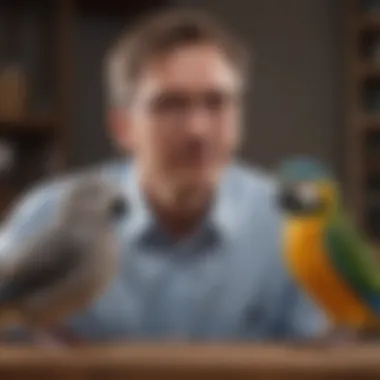
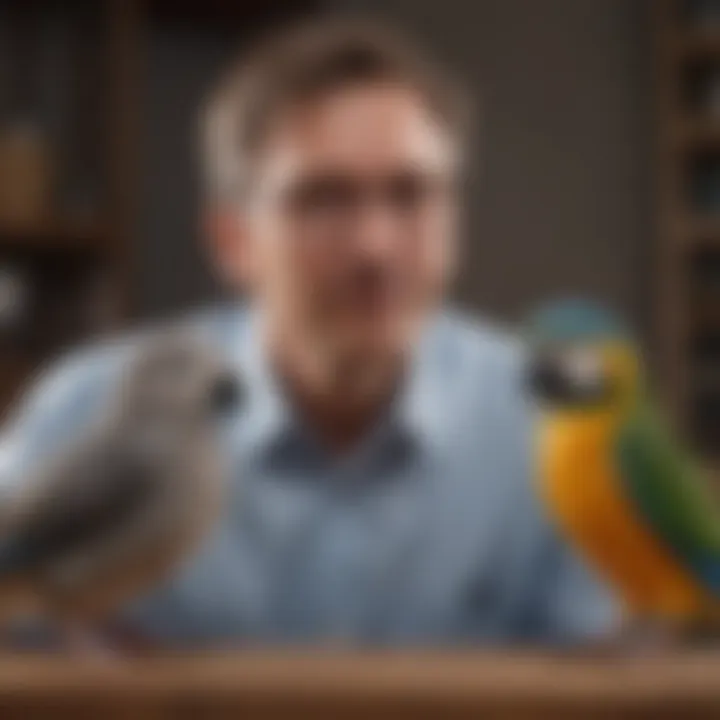
Behavioral issues are another significant consequence of collar plucking. Birds may develop a pattern of destructive behavior, which includes not just plucking but also excessive vocalization or aggression towards their environment. A key characteristic here is the repetitive nature of these behaviors, which can indicate anxiety or boredom. Understanding these issues gives pet owners clarity on how to improve their pet's environment and curb undesirable actions. The unique feature of behavioral issues is that they often escalate if left unaddressed, leading to a cycle of stress for both the bird and the owner. When a bird exhibits these signs, it often indicates a pressing need for behavioral modification strategies to alleviate their distress.
Impact on Well-Being
Collar plucking poses serious implications for the overall well-being of pet birds. Beyond physical injuries and behavioral changes, it influences their emotional health. Birds that regularly engage in this behavior may suffer from decreased social interaction and overall quality of life. The implications can be vast—stress doesn't only impact the affected birds, it can also affect the dynamic in a household with multiple pets. Owners may observe a change in their pet’s temperament or energy levels, which may alter their relationship.
Recognizing the implications of collar plucking is crucial for proactive pet care. By addressing the underlying causes, owners can ensure their birds have a healthier, happier life.
In summary, the implications of collar plucking extend far beyond the act itself. Owners must carefully monitor their birds, understanding these implications to take appropriate action. Addressing health consequences and behavioral issues helps to create a environment conducive to the well-being of the birds.
Effective Solutions and Management Strategies
Addressing bird collar plucking requires a multifaceted approach that combines understanding, proactive measures, and targeted interventions. This article segment emphasizes the importance of effective solutions and management strategies that promote healthier behaviors in pet birds. By applying these tactics, owners can not only mitigate plucking but also enhance their pets' overall well-being. Employing various strategies can lead to a more enriching environment and alleviate potential health risks associated with collar plucking.
Environmental Enrichment
Environmental enrichment is a crucial component in preventing collar plucking. It involves modifying the bird's surroundings to provide stimulating experiences. This can include introducing toys, perches, and various climbing structures. Birds, being naturally curious and intelligent creatures, benefit significantly from challenges that engage their minds and bodies. Factors such as varied textures, colors, and sounds can create an exciting atmosphere that keeps birds entertained.
Ensuring a dynamic habitat not only improves their mood but also minimizes stress. Additionally, offering foraging opportunities can promote natural behaviors, which further contributes to emotional health.
Behavior Modification Techniques
Training and Reinforcement
Training and reinforcement play a significant role in managing bird behavior. Positive reinforcement is a strategy that rewards desirable behavior, thus encouraging birds to repeat those actions. This method is beneficial for redirecting the focus from collar plucking to engaging activities. The key characteristic of training is its adaptability to individual bird personalities and needs. Birds can learn commands or tricks that create a bond with their owners and distract them from destructive behaviors.
One unique feature of training is its dual benefit: it helps in behavior management while also providing mental stimulation. However, it requires patience and consistency from the owner, as results may take time to manifest.
Distraction Techniques
Distraction techniques focus on redirecting a bird's attention away from plucking. Providing various toys, such as puzzle toys or foraging items, can effectively occupy their time and decrease instances of collar damage. The key characteristic of distraction methods lies in their ability to engage a bird's curiosity and need for activity. It is a popular choice among bird owners because it requires minimal training, making it accessible for everyone. One unique advantage is the wide variety of distractions available, catering to different preferences and play styles. However, relying solely on distraction methods without addressing underlying causes may only provide temporary relief.
Veterinary Intervention
Medical Assessments
Veterinary intervention is sometimes necessary to address collar plucking. Medical assessments help determine if there are underlying health issues contributing to the behavior. The key characteristic of these assessments is their comprehensive nature, which can include physical examinations, skin tests, and blood work. This thorough approach ensures that any physical health concerns are identified and treated promptly.
Regular vet checkups not only lead to early detection of potential issues but also offer insights into best practices for care. One drawback is the potential cost involved, which may vary depending on the veterinarian's recommendations.
Treatment Options
Treatment options for collar plucking can vary greatly, depending on the diagnosed causes. From medication to behavioral therapy, solutions are tailored to the bird's unique needs. The key characteristic of these treatment methods is their individualized approach, considering both physical and psychological factors. This ensures a well-rounded strategy that addresses the root of the problem. A unique feature of treatment options is their potential for positive outcomes when combined with environmental enrichment and behavior modification. However, some treatments may have side effects or require ongoing management, so close monitoring is essential.
Proactive management and informed approaches are essential to combat collar plucking, providing birds with happier and healthier lives.
By incorporating these effective solutions and management strategies, bird owners can nurture a more positive living environment for their pets. Addressing the issue holistically not only improves the birds' emotional health but also fosters stronger relationships between the owner and their avian companions.
Preventative Measures
Preventative measures are crucial in managing bird collar plucking. Understanding and addressing the potential triggers can significantly enhance the quality of life for pet birds. By implementing preventive strategies, bird owners protect their feathered companions from the distress associated with collar plucking. This section focuses on two primary aspects: creating a safe environment and ensuring routine health check-ups.
Creating a Safe Environment
A safe environment is foundational for the well-being of a pet bird. This includes not only physical safety but also emotional security. Birds are sensitive creatures, and their surroundings can influence their behavior and mental health. Key elements in fostering a safe living space include:
- Reducing Stressors: Identify common stressors in the bird's environment. Loud noises, sudden movements, and aggressive interactions with other pets can trigger anxiety. Mitigating these factors can lead to a calmer atmosphere for the bird.
- Providing Shelter: Birds need safe spaces where they can retreat. Adding shelters like covered perches or cozy nests can give them options to hide and feel secure when they feel threatened or anxious.
- Ensuring Social Interaction: Birds are social animals and require interaction to thrive. Ensuring they have enough socialization with humans or other birds can help alleviate feelings of loneliness, which may contribute to plucking behavior.
- Designing Enrichment Activities: Boredom often leads to undesirable behaviors. Providing toys, puzzles, and opportunities for physical exercise helps engage the bird, keeping it mentally stimulated and reducing the risk of behavior like collar plucking.
Routine Health Check-ups
Regular health check-ups are essential in preventing collar plucking. These visits allow for early detection of underlying medical issues. Birds can hide signs of illness, making routine check-ups a valuable strategy for maintaining health. Here are some considerations for bird owners:
- Veterinary Care: Schedule periodic visits to an avian veterinarian who understands bird health. The veterinary professional can conduct thorough examinations and suggest appropriate vaccinations.
- Monitoring Behavior Changes: Owners should observe their birds closely for any changes in behavior or eating habits. These changes can signal health issues that require prompt attention.
- Grooming Practices: Proper grooming is vital in maintaining skin and feather health. Regularly checking for signs of irritation or pests can prevent physical conditions that may lead to collar plucking.
"An ounce of prevention is worth a pound of cure." Taking proactive steps towards maintaining your bird's health and environment is wise.
The End
Understanding the issue of bird collar plucking is crucial for any bird owner or enthusiast. This behavior often signals deeper psychological or physical problems that can impact the overall well-being of birds. Thus, recognizing and addressing the causes of this behavior not only helps in the immediate care of the animal but also enhances the quality of life for pet birds.
Summary of Key Points
To summarize, several key points are worth noting:
- Definition of Collar Plucking: It involves the removal of feathers around a bird's collar area, which can arise from various causes.
- Prevalence Among Species: Different bird species show unique susceptibilities to collar plucking, influenced by genetic and environmental factors.
- Causes: The behavior can stem from psychological factors like anxiety and stress, physical issues such as skin irritation or parasites, and environmental triggers.
- Implications: Collar plucking can result in significant health risks, affecting both physical condition and behavioral health of the affected birds.
- Management Strategies: Implementing techniques like environmental enrichment, behavior modification, and veterinary care is essential in addressing this problem.
- Preventative Measures: Owners can create safer environments and ensure regular health check-ups to decrease the occurrence of collar plucking.
Final Thoughts on Bird Ownership
In reflection, being a responsible bird owner goes beyond mere companionship. It involves a deeper understanding of the animals’ needs. Bird collar plucking is a symptom of broader issues that can affect their health and happiness. By taking proactive steps to understand and manage this behavior, pet owners can significantly improve their birds’ lives. The benefits extend not just to the birds, but also to the bond shared between them and their caretakers. Ultimately, a well-cared-for bird thrives, providing joy and companionship in return.















